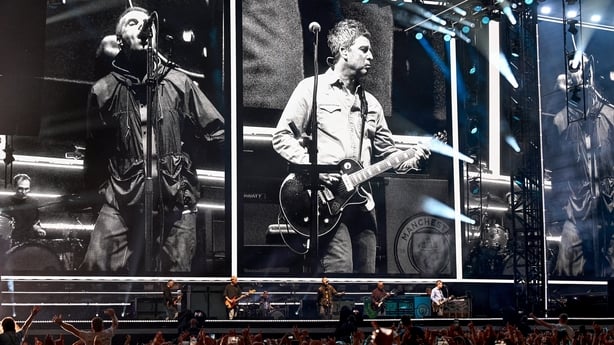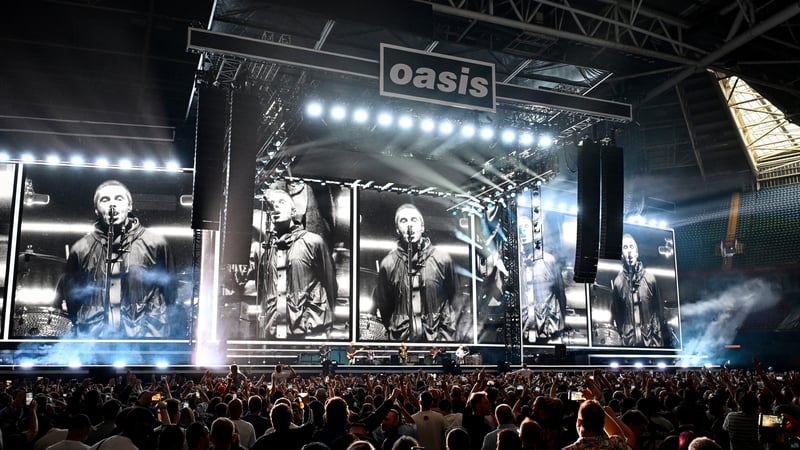It’s less than two weeks until the Gallagher brothers take to the Croke Park stage as part of the Irish leg of their long-awaited reunion tour – but they’re not the only ones on the comeback trail.
In the past three years alone we’ve had Pulp and Blur reunite, as well as Sugababes, JLS, S Club, Blink 182, Busted, My Chemical Romance and Five – which have two shows coming up in the 3Arena later this year.
Obviously, reunion tours are nothing new – they’ve been a feature of the live music scene in one way or another for decades. But the nature – and frequency – of the reunion gig has changed dramatically in a short space of time.
In the past a group might have hit the road again as a last hurrah – looking to take the opportunity to pad out the pension fund while they were still able to manage a gruelling tour schedule. And they were less common, too, or incomplete due to band members opting out or passing away before they reached ‘farewell tour’ age.
Nowadays, though, groups seem to be reuniting at a much earlier age. And, far from being seen as a cynical cash-grab, audiences are crying out for a chance to see these comeback kids.
Why is this happening?

It goes without saying that the artists are, first and foremost, getting back together for the love of the music… their art is what motivates them more than anything else.
But it’s not being too cynical to point out that there’s also an often significant financial incentive to them hitting the road at an earlier stage in their band history.
To better explain that, it’s worth going back a few decades – and looking at how bands and musicians would have made their money in the 70s, 80s and 90s.
Back then making money in the industry was really all about the physical music – single and album sales where what you were trying to drum up.
The tour was maybe an add-on – but it wasn’t the main event. In fact some cases artists would have made little or no money from their tour, but did so because gigging was a good way to drum up physical sales.
The beauty in this model was that, even if you were a band who fizzled out after the first few albums – or gave up touring altogether, you would probably continue to enjoy decent revenues from sales well in to the future. Because you would have new generations of audiences finding your albums years later, And if you needed to boost your bank balance a little you could always push out a special edition, or a 10th or 20th anniversary collectable with a crappy demo bonus track added on, which would sell well on reputation alone.
But of course that’s all changed now thanks to streaming. Most people don’t spend very much money on physical music nowadays. And of the money they do spend on accessing recorded music, very little of it makes its way to the artists. Even acts that are drumming up millions of streams are getting really paltry sums of money from Spotify and Apple Music.
That means that touring – as well as merchandise – is now where you go if you want to have any hope of making money as an artist.
A report by the Irish Music Rights Organisation last month said that the music industry contributes €1 billion to the Irish economy each year – and €786m of that comes from live events (though it’s worth nothing that that spend would include what gig-goers drop on travel, accommodation, food and drink and possibly merch too).
The report said consumers spend an average of 1,000 a year on music – and €757 of that goes towards live music.
So you can take from that that the vast majority of money that’s up for grabs for artists is available to them on the road.
And people having money to spend is an important factor in all of this.
Because the people who were listening to Five or the Sugababes or My Chemical Romance as tweens and teens are now maybe in their 30s – and there’s a good chance they have a bit more disposable income now than they did the first time around.
They will be far more willing, and able, to spend a few hundred euro on gigs each year. That means the acts that were popular with young people in the 1990s and 2000s have an opportunity to cash in on that fanbase in a way that wasn’t possible when they were at the peak of their popularity. It’s suddenly much easier for them to convince their fans to pay through the nose for concert tickets, and still pay €50 for a t-shirt or a poster while they’re there.
So in a lot of ways the economics of music have been flipped – bands used to tour to promote an album, now they might put out an album to drum up hype for a tour.
Although in a lot of cases these reunited bands don’t even put new music out…

True; and Oasis is the perfect example of that.
There’s been absolutely no suggestion that they’re going to go back into the studio, and it’s fair to say that the fans don’t care about that. All they want is for the band to finish the tour that they’ve announced – and ideally add a few more dates on down the line.
Now maybe that’s because the latter part of Oasis’ back catalogue wasn’t exactly their best work (those who disagree just need to look at the setlist for the reunion tour to see that Noel and Liam feel the same).
However the fact that there’s little demand for new music also points to some of the other reasons why these kinds of reunion tours are in such strong demand at the moment.
Specifically in the case of Oasis, there’s obviously a supply and demand factor. People haven’t been able to see them play live together in at least 16 years, so there’s a massive pent up demand. Had they stayed on good terms through the years and done a tour every year or two, they might not have seen such a clamour for tickets this time around.
That being said, acts like Five, Pulp and Blur have done reunion tours before and are still seeing demand this time around – so having a keen audience is not just about laying low for a few years and then coming back.
So what’s creating such strong demand for these reunions?

The pandemic can take part of the blame – it really super-charged people’s FOMO, because people missed out really on a couple of years of gig-going. And now they want to make up for lost time, and mark some acts off their bucket lists.
Perhaps another factor is the fact that we’re living in a more nostalgic time than has ever been the case before – in part because streaming TV and music has put so much older content at our fingertips. Our smartphones are also, constantly generating photo albums of things we did just a few years ago – which encourages us to get wistful about our younger days which – in turn – makes us pine for the music we listened to at the time.
At the same time that instant access to older content has made it much easier for younger people to discover and create a love for music that they were maybe a little bit too young for the first time around.
There will no doubt be plenty of people in their late teens and early 20s at the Oasis concerts this month – alongside those who were grown-ups when they first heard Wonderwall. (In fact the demand for tickets from newer fans did spark a brief, nasty debate online which saw some older fans argue that they deserved tickets more than the newcomers (and, particularly, the younger women who wanted to go).
So just how lucrative are these kinds of reunion tours?

Well it obviously all depends – and there are a lot of factors at play.
But it’s likely that Oasis will be behind the year’s biggest reunion, in financial terms if nothing else. It’s estimated that they could be looking at revenues of more than €460m for their current tour – even assuming it is not extended beyond its current 41 date run.
Now that is revenue for the whole tour –from that they’ll need to cover a lot of costs including venue hire, staging, crewing, transport and so on.
However it seems as though there will still be plenty left for the talent when all the bills are covered. The reports are that each of the Gallagher brothers could be walking away with upwards of €50m each – with even more potential income from merch and the inevitable boost to album sales/streams.
For other bands it’s probably not quite as lucrative – but all the same you’d imagine they could be building up a decent sum of money for themselves
To take the example of Five– while they’re not playing the same sized venues as Oasis, they are doing 25 nights in venues that are in the 10,000 to 15,000 seater range. Many of those nights are already sold out – or close to being sold out.
So even if it’s not tens of millions each, you would imagine there is a significant amount of money being generated for the group from their tour.




